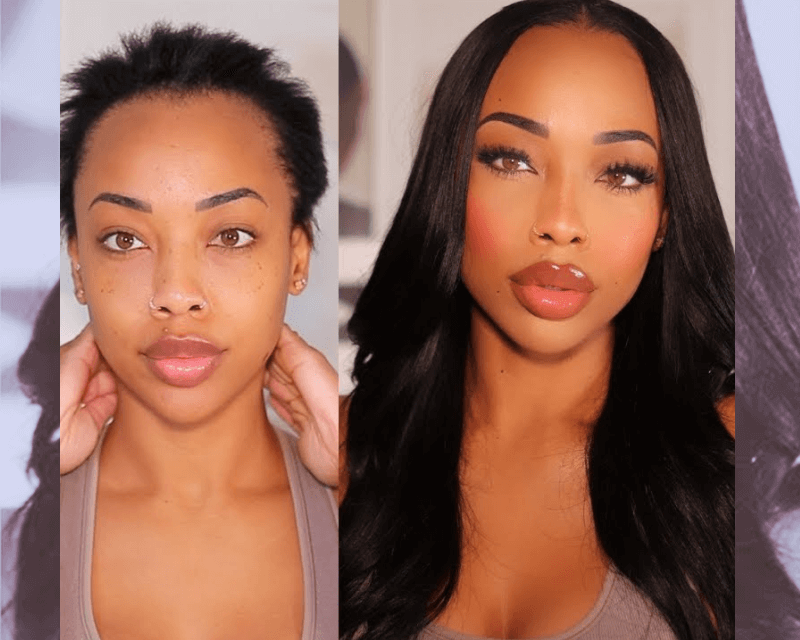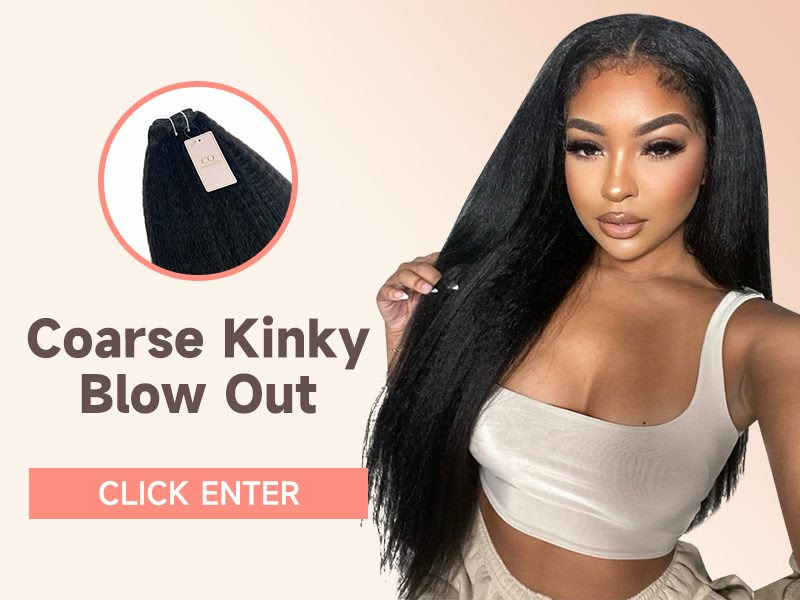
Pixie cuts are a stylish choice for women on the go who are looking to refresh their look or adopt a new style. However, for those dealing with thinning or receding hairlines, cutting hair might be a necessity for recovery. Whatever your situation, growing out a pixie cut can feel daunting yet thrilling. With the right choose and use of human hair extensions and wigs, you can successfully navigate this transition.
In this blog, delve into effective solutions and tips with BL to help you smoothly transition from a pixie cut to longer, fuller hair while maintaining a natural appearance.
Know Your Unique Hair Before Selecting Hair Extensions or a Wig
Hair Volume:
Before diving into solutions,it’s essential to understand your hair. This knowledge will help you choose the right extensions or wigs that blend seamlessly with your natural locks.
Density and Evenness of Hair Growth:

Evaluate the density and evenness of your hair growth.If certain areas are sparse, have bald patches, or are receding, consider solutions that can strategically enhance volume where needed to ensure a balanced look.
Hair Type and Texture:
Identify your hair type and texture—whether it’s fine,medium,coarse;
straight, wavy, or curly. This will guide you in selecting extensions or wigs that match your natural hair, creating a more cohesive appearance.
Color
Color Compatibility: Consider what shades complement your natural hair, face, and style better by looking over your album. Consider highlights or lowlights to create a blended look. For subtle contrast, opt for colors that are just a few shades lighter or darker.
Undertones: Consider the undertones of your hair (warm or cool) and select extensions with matching undertones to avoid clashing.
Check out other blogs to learn more tips for choosing different hair textures and color matching.
How to Seamlessly Blend Clip-Ins with Short, Thin Hair?
Why Your Hair Extensions Don't Blend: Common Mistakes and Fixes
Know the Differences Between Main Types of Hair Extensions and Wigs
| Install Methods | Install Limitations on Natural Hair Length |
Wearing Cycles | Installation Time | |
| Clip-in extensions |
Clip the extensions onto natural hair using the attached clips. | 3 inches | Temporary extensions allow to be put on and remove instantly. |
15-30 Minutes |
| Weft hair extensions | Sew the wefts onto natural hair, or use glue to attach extensions to hair. |
4-6 inches | Sew-in: 4-12 weeks Quick weave: 6-8 weeks |
1.5-2 hours |
| Microlink Beads weft hair extensions |
Install by threading small sections of natural hair through a bead along with a weft of hair. | 4 inches | 8-12 weeks | 1-2 hours |
| Microlink Itip hair extensions |
Install by attaching small, stick-like keratin-bonded pieces of hair to natural hair using a micro-link bead. | 4 inches | 8-12 weeks | 1.5-2 hours |
| Tape-in hair extensions |
Install by sandwiching thin, small pieces of extensions between sections of your natural hair using adhesive tape. |
3-4 inches | 6-8 weeks | 1-2 hours |
Understanding the various types of hair extensions is crucial for making informed choices. Here are the most common types, including their installation times and skill requirements:
1. Clip-in Extensions
Installation Method: Temporary extensions that clip into your hair.
Installation Time: Approximately 10-15 minutes for application.
Installation Skill Requirements: Very low; anyone can apply clip-ins without professional help.
Pros: Easy to apply and remove, perfect for occasional use.
Cons: Not ideal for long-term wear; can slip out if not secured properly.
2. Tape-in Extensions
Install Method: Wefts of hair are attached to your natural hair with adhesive tape.
Installation Time: Typically takes about 30-60 minutes.
Installation Skill Requirements: Moderate; best applied by a professional for optimal results and longevity.
Pros: Flat and lightweight, providing a natural look; can last several weeks with proper care.
Cons: Requires professional installation and removal; not as reusable as other types.
![]()
3. Weave bundle Weft Hair Extensions
Install Method: Hair wefts are either sewn into braided sections of your natural hair or glued directly onto a protective weave cap.
Installation Time: Usually takes 1-3 hours, depending on the desired fullness.
Installation Skill Requirements: High; requires professional skills to prevent damage and ensure a secure fit.
Pros: Long-lasting and secure; suitable for various textures.
Cons: Can cause tension on the scalp if not done correctly.
4. Microlink Hair Extensions (Microlink I-Tip Hair Extensions and Micro Beads Weft Hair Extensions)
Install Method: These extensions use small beads or links to attach hair strands to your natural hair without glue or heat.
Installation Time: Takes about 2-4 hours.
Installation Skill Requirements: High; requires a skilled stylist for proper placement and to avoid damage.
Pros: Offers a natural look and allows for movement; suitable for various hair types.
Cons: Requires maintenance to avoid slippage; can be time-consuming to install.
5. Wigs
Recently, machine-made wigs have been selling better due to their affordability and consistent quality. These wigs typically come in several types, including lace front wigs, U-part wigs, and drawstring ponytail wigs, each offering unique benefits. With a wide range of colors and styles available, they cater to various preferences.
Install Method: Wigs with full hairpieces that cover the entire head.
Installation Time: Can be put on in about 5-10 minutes for ready-to-wear wigs; more time if customizing.
Installation Skill Requirements: Low to moderate; basic styling skills can enhance the look, but no professional help is needed for application.
Pros: Instant length and volume; versatile styling options.
Cons: Can be hot and uncomfortable for long wear; requires maintenance.
How to Choose Fitting Solutions to Lengthen and Add Volume to Your Pixie Cut
When choosing hair extensions, it's essential to consider both the time required for installation and the financial investment involved. Here's a breakdown of the financial costs associated with each main type of extension:
1. Considering Your Wearing Time and Frequency
Think about how often you plan to wear extensions or wigs. If you want a temporary change, clip-ins or wigs are ideal. For a more permanent solution, tape-ins or sew-ins may be better suited.
2. Considering the Time and Financial Investment
When aiming for a natural blend with a pixie cut, human hair extensions are the top recommendation due to their superior quality and realistic appearance. Extensions and wigs vary in costs and maintenance needs.so it's crucial to consider both the hair costs and installation costs. Here are the prices offered in the U.S.:
Clip-in Extensions
Hair Cost: Typically ranges from $100 to $300 for high-quality human hair clip in extensions.
Installation Cost: Generally, no professional installation is needed; if desired, it can cost around $60 to $180.

![]()
Tape-in Extensions
Hair Cost: Generally costs between $200 and $600 for human hair.
Installation Cost: Professional installation typically ranges from $240 to $450.
Weave Bundle Weft Hair Extensions
Hair Cost: High-quality human hair wefts usually range from $200 to $600.
Installation Cost: Professional installation for sew ins and quick weave costs between $180 and $450.
Microlink Hair Extensions
Hair Cost: Typically ranges from $200 to $800 for high-quality human hair.
Installation Cost: Expect to pay between $200 and $400 for professional installation.
Wigs
Hair Cost: For human hair wigs, prices can range from $200 to over $1,000, depending on quality and length.
Installation Cost: While many wigs can be worn without professional help, customization or secure fitting services can cost between $300 and $600.
From Super Thin to Thick Hair:The Best Solutions for Various Pixie Cuts
1.Best Solutions for Medium to Thick Pixie Cut
Clip-in Extensions:
- Flexibility for specific section use : They allow you to add hair to specific sections as desired without weighing down the entire hairstyle.
- Convenient for temporary use: Allows you to put it on or remove it at any time without the need for a semi-permanent installation lasting weeks or months.
- User-Friendly: Easy to install and remove, making them a super beginner friendly choice.
- Versatile Styling
2.Best Solutions for Fine to Medium Pixie Cuts with Even Growth
Tape-ins,clip-ins,Microlink extensions:
- Versatile Styling Options: These methods provide flexibility in styling.
- Seamless Blending: Allow for a natural blend with existing hair.
Half Wigs(Includes styles like drawstring pony wigs and U-part wigs)
- Large coverage area: Half wigs can cover most of the scalp area,best for women with fine to medium pixie cuts with even growth.
- Easy Blending: Allows for simple integration with natural hair.
- Protective: Offers a lightweight option that protects the hair.
- Convenient: Allow women with to grow out a pixie cut effortlessly.
3.Best Solutions for Receding Hairlines, Bald Patches, and Super Thin Pixie Cuts
Closure with Weave Bundles:
- Full Coverage: Closures with sew in bundles offer complete coverage of the scalp.
- Hides Imperfections: They effectively conceal receding hairlines and thinning areas.
- Protect thinning Hair: The design prevents added stress on fragile hair.
- Seamless Look: Closures with weave bundles create a smooth, natural appearance.
- Ideal for Sparse Hair: They are particularly suitable for women with sparse hair.
Lace front wigs:
- Full Coverage: The hand crochet hair strands hair on front provide complete coverage while enhancing overall appearance.
- Ideal for Thinning or receding Hair: They are particularly suitable for super thin hair and sparse spots.
- Comfortable: The lightweight lace allows for a comfortable fit.
4.Best solutions for fine,uneven growth pixie cuts
- Hybrid Hair Application:This combining different methods, such as sew-ins with I-tip microlinks, tape-ins with sew ins and sew-ins with clip -ins.
- Ideal for Fine or Uneven Growth hair: These applications are especially suited for fine or uneven hair growth.
- Seamless Attachment: Tape-ins and I-tip microlinks attach closely to the roots, reducing tension.
- Versatile Styling Options: Offers a range of styling possibilities.
Try Useful Tips for Blending Short Hair with Extensions and Wigs
Focus on Leave-Out: To ensure a seamless integration, carefully match the texture and color of your leave-out—the natural hair left out to blend with the extensions or wig. This helps create a smooth and natural transition.
Style Your Edges: For a refined look, style your edges meticulously. Apply a lightweight edge control product to tame and sculpt your baby hairs, enhancing the wig or extension's overall appearance.
Finish Styling: Whether you opt to curl, straighten, or keep it in a protective style, ensure that the chosen style enhances your overall appearance.
Trim for Face Framing: If necessary, trim your natural hair to better frame your face and complement the extensions or wig. A well-executed trim can promote a cohesive look, aiding in a flawless blend.
Conclusion
Are you ready to transform your pixie cut into luxurious, flowing locks? Discover our expert tips and effective solutions for growing out your hair using high-quality human hair extensions. Start your hair journey today and unlock the secrets to achieving the length and volume you've always desired. Explore CURLSQUEEN's blogs and our diverse range of human hair extensions and wigs, and begin your stunning transformation now!

